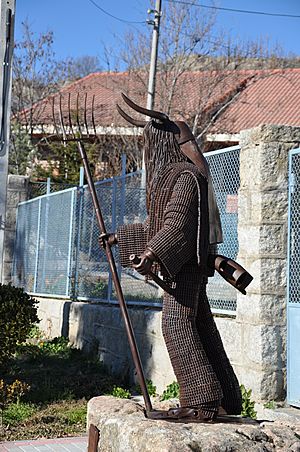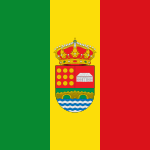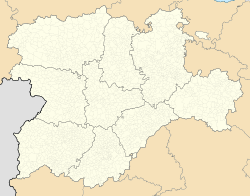Navalosa facts for kids
Quick facts for kids
Navalosa
|
|||
|---|---|---|---|

Cucurrumacho, character of the carnival in Navalosa
|
|||
|
|||
| Country | |||
| Autonomous community | |||
| Province | |||
| Municipality | Navalosa | ||
| Area | |||
| • Total | 30 km2 (10 sq mi) | ||
| Population
(2018)
|
|||
| • Total | 321 | ||
| • Density | 10.7/km2 (28/sq mi) | ||
| Time zone | UTC+1 (CET) | ||
| • Summer (DST) | UTC+2 (CEST) | ||
Navalosa is a small and charming town located in the province of Ávila, which is part of the Castile and León region in Spain. It's a place where you can experience traditional Spanish village life.
Contents
Navalosa is a municipality. A municipality is like a local government area. It includes the main town and sometimes nearby smaller villages or countryside. Navalosa is known for its quiet charm and beautiful natural surroundings.
Navalosa is in the central part of Spain. It sits within the Province of Ávila. This province is famous for its historic cities and lovely landscapes. The town is surrounded by nature, making it a great spot for outdoor activities.
As of 2018, about 321 people live in Navalosa. This makes it a small community. People here often know each other well. Life in Navalosa is peaceful. It is different from living in a big city. The town covers an area of about 30 square kilometers.
The Cucurrumacho Carnival
One of the most exciting things about Navalosa is its unique carnival. It features a special character called the Cucurrumacho. This character is a big part of the town's traditions.
What is a Cucurrumacho?
The Cucurrumacho is a traditional figure. It appears during the carnival celebrations. People dress up in special costumes. These costumes often include animal skins and horns. They also wear masks. The Cucurrumacho is meant to be a bit scary. It adds excitement to the carnival.
Carnival Traditions
The carnival in Navalosa is a lively event. It usually happens before Lent. People gather to watch parades and enjoy the festivities. The Cucurrumacho runs through the streets. It playfully interacts with the crowd. This tradition has been passed down for many years. It helps keep the town's culture alive.
See also
 In Spanish: Navalosa para niños
In Spanish: Navalosa para niños





